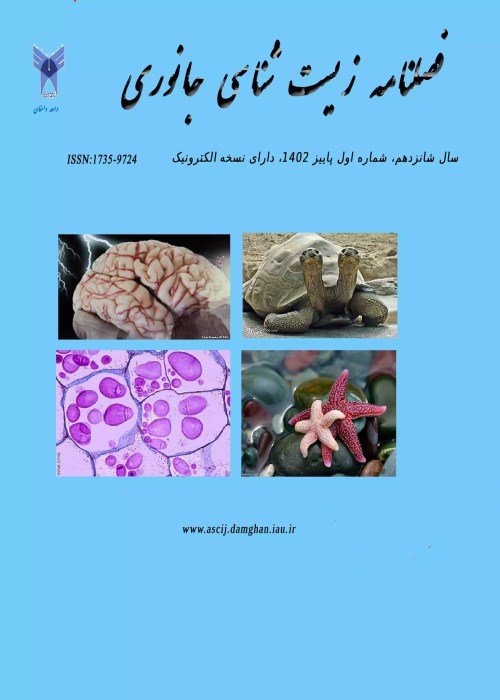Seasonal Variation of Glutathione S Transferase and Heavy Metal Pollution (Pb, Cd and Ni) in Pinctada radiata
Author(s):
Abstract:
There are various tools for monitoring the concentration of pollutants on aquatic ecosystems. Today these studies are based on biological monitoring and biomarkers. The aim of this study was to measure the concentration of the glutathione S-transferase as biomarkers of heavy metal contamination in pearl oyster Pinctada radiata in aquatic ecosystems. Heavy metals lead, cadmium and nickel were measured in soft tissue and studied stations in four seasons. Samples were collected seasonally in Lavan stations, Hendurabi and Nakhilo (in the northern Persian Gulf) from spring 2013 to winter of that year by scuba diving. Pearl oysters are divided according to their shells size; shells separated from soft tissues and were transferred to the laboratory for analysis of heavy metals and enzymes. Moopam standard method for were used for measuring the concentration of heavy metals and for analyzing tissue concentrations of glutathione S-transferase in Clam the method recommended by Habig et al In 1974 were used. The concentration analysis of heavy metals nickel, cadmium and lead in sediments at all stations were 1.6 ± 0.12 and 0.69 ± 0.04 and 4.16 ± 0.30 ppm, and the concentration analysis of heavy metals nickel, cadmium and lead in the soft tissue of Pinctada radiata in all three stations, respectively 0.12 ± 0.58 and 1.86 ± 0.04 and 1.94 ± 0.30 in parts per million, That results showed that the concentration of lead has significant difference in sediments station, Compare the results of this study with standards related and other similar studies at the regional and international level showed that pollutant concentration of heavy metals in all cases significantly less than all the standards and guide values associated. The concentration of glutathione S-transferase was almost similar to each other and parameters, station and seasons were significantly different in the concentrations of this enzyme. Seasonal changes in antioxidant enzymes related to (assuming a constant in salinity and oxygen) to age, reproductive cycle, and availability of food and water temperature. With increasing temperature at warm season, antioxidant enzymes were increase, with increasing temperature and abundance of food in the environment the amount of antioxidant enzymes may increase. The presence of the enzyme concentration may indicate that the higher levels of the enzyme to eliminate ROS activities to be any healthier situation. Due to low pollutants of heavy metals in the study area, a lower level of contaminants were observed in shellfish tissue and strong correlation between the amount of heavy metal contamination in pearl oyster tissue and enzymes was not observed, Therefore, we can say that the pearl oyster remains in a healthy condition and the amount of enzyme is normal.
Keywords:
Pinctada radiata , Persian Gulf , enzyme , Heavy metal , Hendurabi , Lavan , Nakhilo
Language:
Persian
Published:
Journal of Animal Biology, Volume:9 Issue: 3, 2017
Pages:
77 to 93
magiran.com/p1707552
دانلود و مطالعه متن این مقاله با یکی از روشهای زیر امکان پذیر است:
اشتراک شخصی
با عضویت و پرداخت آنلاین حق اشتراک یکساله به مبلغ 1,390,000ريال میتوانید 70 عنوان مطلب دانلود کنید!
اشتراک سازمانی
به کتابخانه دانشگاه یا محل کار خود پیشنهاد کنید تا اشتراک سازمانی این پایگاه را برای دسترسی نامحدود همه کاربران به متن مطالب تهیه نمایند!
توجه!
- حق عضویت دریافتی صرف حمایت از نشریات عضو و نگهداری، تکمیل و توسعه مگیران میشود.
- پرداخت حق اشتراک و دانلود مقالات اجازه بازنشر آن در سایر رسانههای چاپی و دیجیتال را به کاربر نمیدهد.
In order to view content subscription is required
Personal subscription
Subscribe magiran.com for 70 € euros via PayPal and download 70 articles during a year.
Organization subscription
Please contact us to subscribe your university or library for unlimited access!


